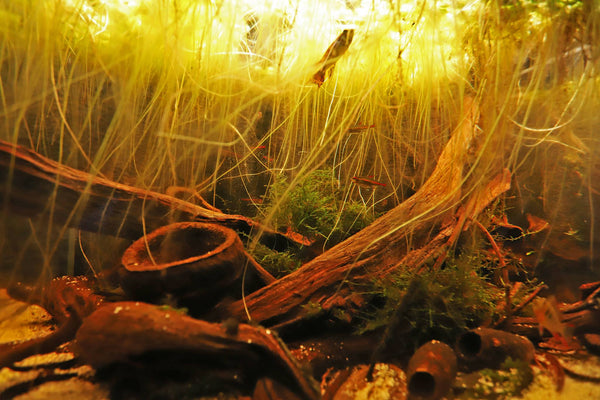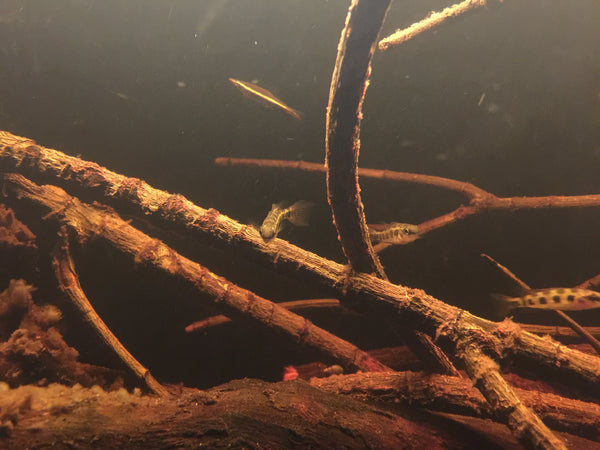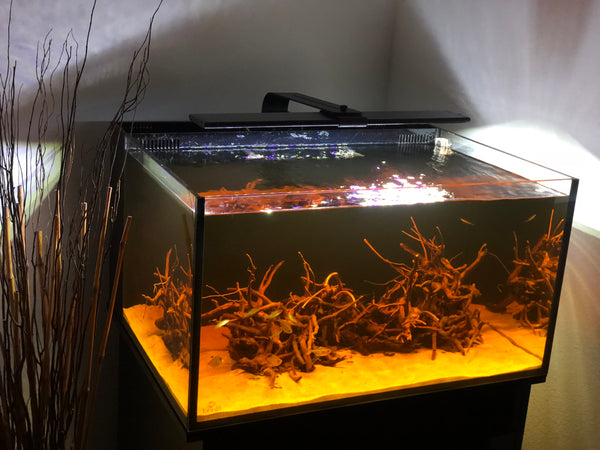- Continue Shopping
- Your Cart is Empty
Myth vs. Fact: Four Common Topics...
One of the interesting things about the aquarium hobby is that we have an incredible "body of work", with hobbyists worldwide working on stuff that might be absurdly arcane or obscure, in almost every area of hobby practice.
Yet, with all of the specialization, research, and accumulated experience in the hobby, we seem to have a pervasive culture of embracing popular perception, almost without questioning or doing any independent research.
While that may be a rather harsh, seemingly over-generalized statement, the reality is that it's often true. When we first dove into the dark world of blackwater aquariums here at Tannin, we were simply aghast at the incredible amount of unsubstantiated, speculative, and unverified "information" out there in the hobby literature and online media.
There were rampant assumptions, and the passing on of many ideas without any personal experience with the subject. Some were simply wrong. Others had some conditional validity to them, but were overly-genrlaized in nature. It was actually almost humorous, although the fact that it may have discouraged so many hobbyists from even attempting to keep this type of system was kind of sad, and showed the power and danger of the process of "regurgitation" in the hobby.
It's only through continuous, methodical, skeptical, and diligent work on these types of tanks that we've been able to break through and start pushing back with actual personal experience against some of the less helpful and more pervasive "myths" that are so prevalent in this sector.
Let's look at four of the most pervasive and long-running myths that, in my opinion, have contributed to much of the hesitancy that many hobbyists may have had over the years about creating and maintaining one of these amazing aquariums for themselves!
MYTH: "Blackwater" is another name for "dirty water."
FACT: Oh, man, if I had a dollar/euro for every time I heard this or read this, I wouldn't be selling dried seed pods and leaves for a living! In the culture of aquarium keeping, there seems to be this perception that water with a color to it is somehow a sign of a dirty, poorly-maintained aquarium. There is a certain "stigma" that we attach to water that isn't blue white and crystal-clear.
Now, the reality is that many of the wild aquatic habitats from which a lot of our fave fishes come from are anything but "crystal clear." As we know now, the influence of factors like soil, and the presence of terrestrial materials like seed pods, leaves, and branches play a huge role in the chemical composition and appearance of the water. It's really no different in the aquarium, right? Tannins from wood and botanical materials will leach into the water, providing the characteristic "tint" that we've become so accustomed to in our little niche.
And that's just fine with us. You can easily have very high water quality (ie; low in nitrates, phosphates, and other substances) and still have a 'tint." In fact, water can be of very high quality and have an almost "patina" of finely dissolving materials in it and still test at high water quality levels. In our type of aquarium, the color is no indication of the quality of the water. Water exchanges, use of chemical filtration media, and good-old common sense will see to that.
MYTH: Blackwater, botanical-style aquariums are difficult to control, and you risk a "pH crash" and wildly fluctuating environmental conditions.
FACT: This one is one of those aquarium hobby "myths" which has really taken hold among many. Now, some of this might have a grain of truth to it, but it's really an example of an over-generalized assumption. Simply adding botanical materials to a closed aquarium environment is adding to the bioload of the system, and can certainly have an impact on the water quality if you don't go slowly, observe carefully, and execute standard aquarium husbandry procedures (e.g., water exchanges, use of chemical filtration media, proper stocking, feeding etc.).
The reality, especially in regards to pH, is that the impact of botanicals on pH is often surprisingly limited, in terms of lowering it. Two of the most important factors are the carbonate hardness of the water and the starting pH. If you have hard, alkaline tap water, and are not doing other things to modify it (ie; utilizing reverse osmosis/deionization), you will likely notice minimal impact on the pH. On the other hand, if you're utilizing water with little or no carbonate hardness and a lower starting pH, these materials can have more significant impact.

The idea of a "crash" is something that has multiple factors involved-including (and there's no nice way to state it) "human error." When you add botanicals to your aquarium- materials which can impact the water quality and the chemistry- it is up to you to go slowly, adding materials in a measured manner...and to test your basic water parameters (pH, alkalinity, nitrite, nitrate, etc.) as you begin the process, and regularly as you work with them. As with any aquarium, botanical-style aquariums are simply not "set-and-forget" systems. They require the same traditional management techniques that are applied to any successful aquarium.
MYTH: You can't grow plants in a blackwater aquarium.
FACT: Now, the reality is that many blackwater habitats are devoid of aquatic plants, or somewhat limited, the fact is there are many species which can be grown under appropriate conditions. Species like Cryptocoryne, Bucephalandra, Polygonum, Didiplis diandra, Mayaca fluviatilis, Isoetes, Eichornia natans Nymphoides sp., and many more. Rather than relying just on aquarium hobby literature, do some research online of scientific studies/surveys of blackwater habitats, and you'll find a surprisingly large amount of useful information!
The limiting factors in a blackwater aquarium are not surprising: The ability of light to penetrate the water column, and the availability of nutrients for the plants to utilize for growth. These are things that we can really overcome, right? By utilizing more intense light (to overcome the tinted water) and the proper application of nutrients, coupled with an appropriately rich substrate, you'd be surprised how easily you can grow aquatic plants in these types of aquariums. This is an area in which we simply need to do the research, as opposed to accepting the more popular- and frankly, wrong- "popular perception."
MYTH: As botanical materials decompose in the aquarium, they degrade the water quality.
FACT: This is another popularly-embraced idea which I can't entirely brush off, because there is some validity to it, and it would be irresponsible of me to dismiss it outright. Let's face it- when you have materials of any type breaking down in the aquarium, they are part of the bioload- and that requires an appropriately-sized population of beneficial bacteria and fungi to break down these materials without adversely affecting water quality. We've written about this idea many, many times here in "The Tint", and talked about the "ecosystem" aspect of working with this type of aquarium quite a bit.
Now, that being said, it would be utterly irresponsible of us to say that you can simply add stuff to an aquarium- specifically one that has been in a stable existence for some time- and not be concerned about any impact on water quality. That's part of the reason why we plead with you to go slowly when adding these materials to an established tank, and to test and gauge the impact on your water quality.

Going slowly not only allows you time to react- it gives your bacterial and fungal population the opportunity to grow and adjust to the increased bioload. These organisms can go a long way towards creating a stable, healthy botanical aquarium environment...But they can't work miracles- and they can't do it alone. And of course, common sense husbandry procedures, like regular water exchanges, use of chemical filtration media (activated carbon, PolyFilter, etc.) give you an added layer of "insurance." A healthy dose of common sense and judgement goes a long way towards a successful outcome!
I can't help but reiterate once again that blackwater, botanical-style aquariums are no more difficult to set up and maintain than any other type of aquarium. They do require understanding of what's going on and what is involved, observation, and upkeep...And, if you're not careful about following good common sense procedures, you can occasionally have a bad outcome. Stuff happens. It's the reality of forging into new territory, but it contributes to the body of knowledge that is the aquarium hobby.

The key takeaway here is to not simply accept everything you read about this type of aquarium (even in our blog!) without giving it a more detailed look yourself, and consulting with those of us who have a lot of personal experience with them. A healthy dose of open-mindedness, coupled with some knowledge and skepticism go a long way towards success!
Obviously, we can't cover every detail about every misunderstood aspect of the blackwater, botanical-style aquarium in the scope of this blog piece. Those of you who visit our web site frequently know that we literally have hundreds of articles on these topics, many of which comprise a sort of "living document" and demonstrate the evolution of the practices that we use and the experiences that we accumulated with this unique hobby niche.

We're all contributing to the "state of the art" of botanical-style blackwater aquariums each and every day!
Stay inquisitive. Stay brave. Stay open-minded. Stay diligent. Stay observant...
And Stay wet.
Scott Fellman
Tannin Aquatics










Scott Fellman
Author